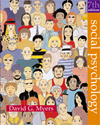 |
1 |  | 
What factor does not initiate attraction? |
|  | A) | long distance |
|  | B) | physical attractiveness |
|  | C) | similarity |
|  | D) | feeling liked |
 |
 |
2 |  | 
According to the text, geographical nearness is |
|  | A) | closeness. |
|  | B) | nearness. |
|  | C) | proximity. |
|  | D) | immediacy. |
 |
 |
3 |  | 
The tendency for novel stimuli to be liked more after the rater has been repeatedly exposed to them is |
|  | A) | the novel stimuli effect. |
|  | B) | the mere-exposure effect. |
|  | C) | the repeated exposure effect. |
|  | D) | the nonsense effect. |
 |
 |
4 |  | 
Which of the following is supported by research on social attraction? |
|  | A) | Distance makes the heart fonder. |
|  | B) | Beauty and brains are equal. |
|  | C) | Opposites attract. |
|  | D) | Familiarity produces fondness. |
 |
 |
5 |  | 
According to the text, what percent of cosmetic surgery is performed on women? |
|  | A) | 90 |
|  | B) | 80 |
|  | C) | 75 |
|  | D) | 65 |
 |
 |
6 |  | 
The tendency for men and women to choose as partners those who are similar in attractiveness and other traits is |
|  | A) | the partner effect. |
|  | B) | the attractiveness effect. |
|  | C) | similarity phenomenon. |
|  | D) | matching phenomenon. |
 |
 |
7 |  | 
The presumption that physically attractive people possess other socially desirable traits is the |
|  | A) | attractiveness effect. |
|  | B) | physical-attractiveness stereotype. |
|  | C) | reciprocity effect. |
|  | D) | matching phenomenon. |
 |
 |
8 |  | 
Which of the following is not a factor given the research on what makes males attractive? |
|  | A) | dominant behavior |
|  | B) | faces that tend to be perfectly symmetrical |
|  | C) | large eyes |
|  | D) | behavior that suggests maturity |
 |
 |
9 |  | 
Women whose waists are 30 percent narrower than their hips suggest a shape associated with |
|  | A) | malnutrition. |
|  | B) | menopause. |
|  | C) | pregnancy. |
|  | D) | peak sexual fertility. |
 |
 |
10 |  | 
According to the text, Black culture tends to be |
|  | A) | future-oriented. |
|  | B) | expressive. |
|  | C) | materialistic. |
|  | D) | individualistic. |
 |
 |
11 |  | 
According to the text, White culture tends to be |
|  | A) | individualistic. |
|  | B) | expressive. |
|  | C) | emotionally driven. |
|  | D) | present-oriented. |
 |
 |
12 |  | 
The evolutionary perspective suggests females are attracted to males who show |
|  | A) | empathy and nurturance. |
|  | B) | an ability to provide. |
|  | C) | high self-esteem and extroversion. |
|  | D) | a similarity in beliefs and values. |
 |
 |
13 |  | 
The use of strategies by which people seek to gain another's favor is called |
|  | A) | ingratiation. |
|  | B) | the curry favor effect. |
|  | C) | manipulation. |
|  | D) | the complementarity effect. |
 |
 |
14 |  | 
Opposites attract is an aspect of the |
|  | A) | matching phenomenon. |
|  | B) | reward theory of attraction. |
|  | C) | complementarity hypothesis. |
|  | D) | the ingratiation effect. |
 |
 |
15 |  | 
A state of intense longing for union with another is called |
|  | A) | romantic love. |
|  | B) | intimate love. |
|  | C) | passionate love. |
|  | D) | consummate love. |
 |
 |
16 |  | 
Susan, who is an extrovert, just moved into a dormitory. Who is she most likely to make friends with? |
|  | A) | Wendy, a mathematics major |
|  | B) | Michele, an introvert who lives on her floor |
|  | C) | Betsy, who lives off campus |
|  | D) | Sasha , her next-door neighbor |
 |
 |
17 |  | 
The affection we feel for those with whom our lives are deeply intertwined is called |
|  | A) | companionate love. |
|  | B) | passionate love. |
|  | C) | intimate love. |
|  | D) | romantic love. |
 |
 |
18 |  | 
People who are skilled in managing first impressions but who tend to be less committed to enduring relationships are |
|  | A) | low in self-monitoring. |
|  | B) | high in self-monitoring. |
|  | C) | high in intimacy. |
|  | D) | low in intimacy. |
 |
 |
19 |  | 
Revealing intimate aspects of oneself to others is called |
|  | A) | self-disclosure. |
|  | B) | the intimacy effect. |
|  | C) | the commitment effect. |
|  | D) | the infatuation effect. |
 |
 |
20 |  | 
People have a greater chance of divorce if they |
|  | A) | are well and similarly educated. |
|  | B) | enjoy a stable income from a good job. |
|  | C) | live in a city. |
|  | D) | dated a long time before marriage. |
 |



 2002 McGraw-Hill Higher Education
2002 McGraw-Hill Higher Education